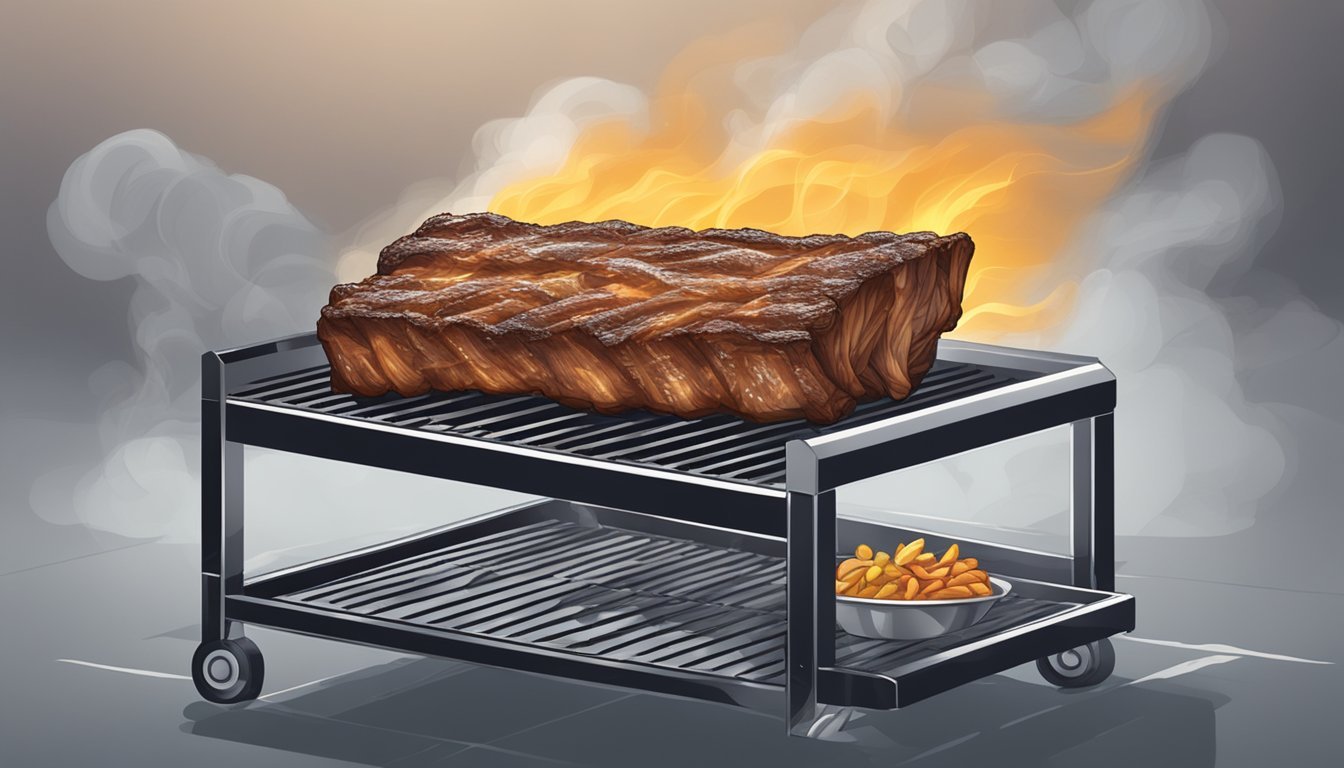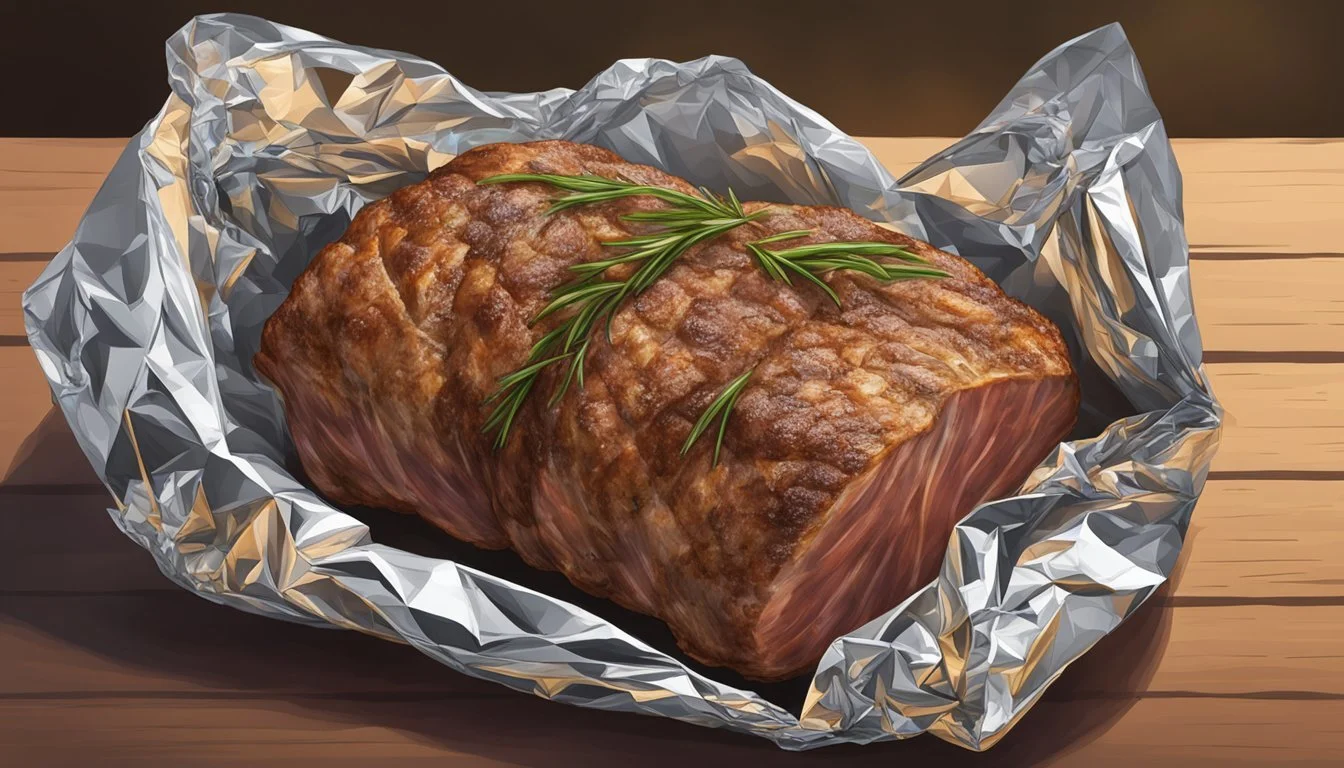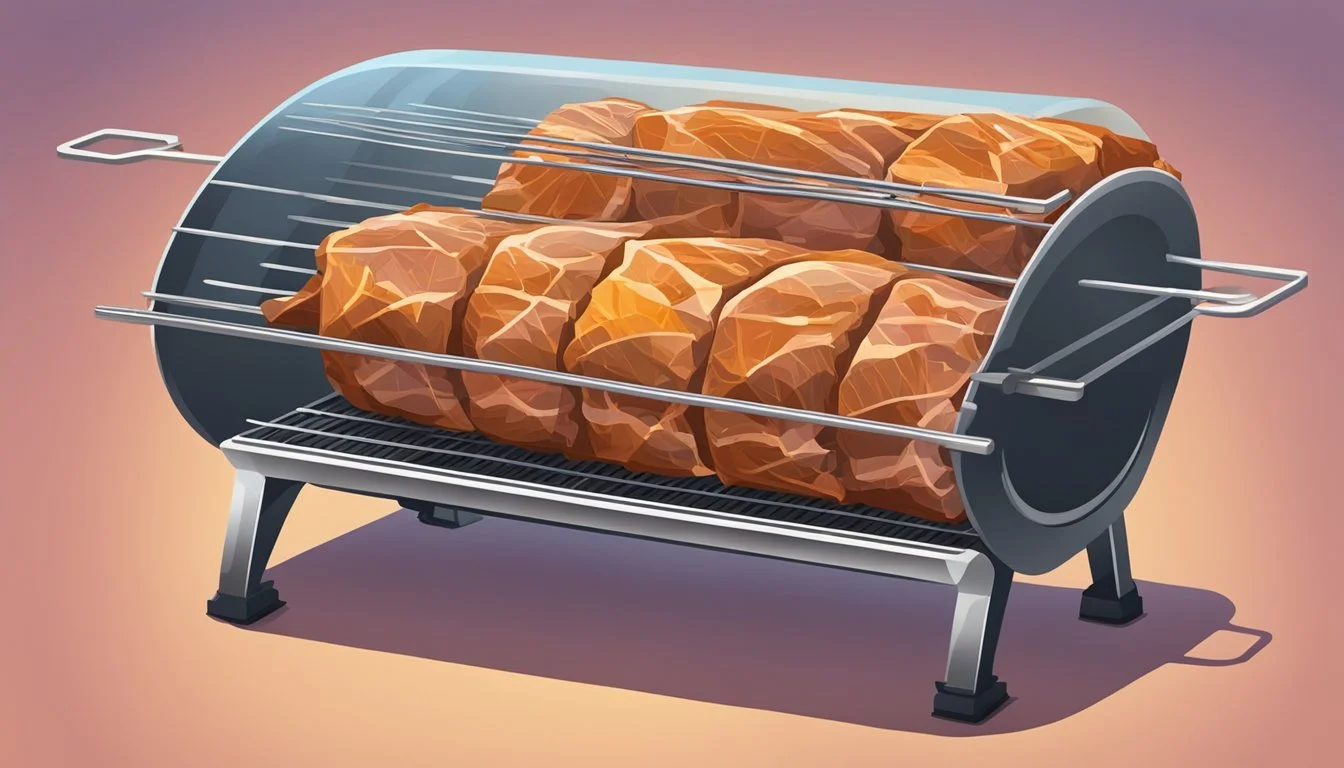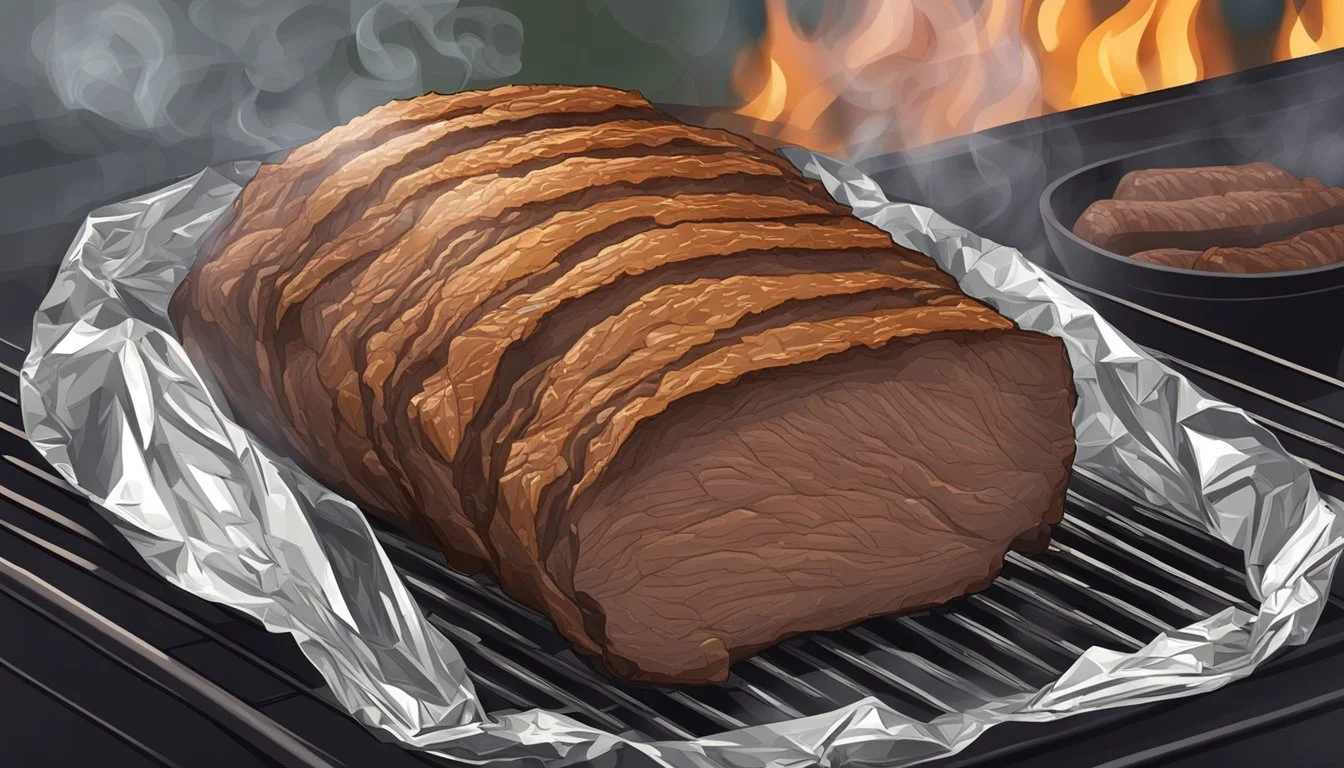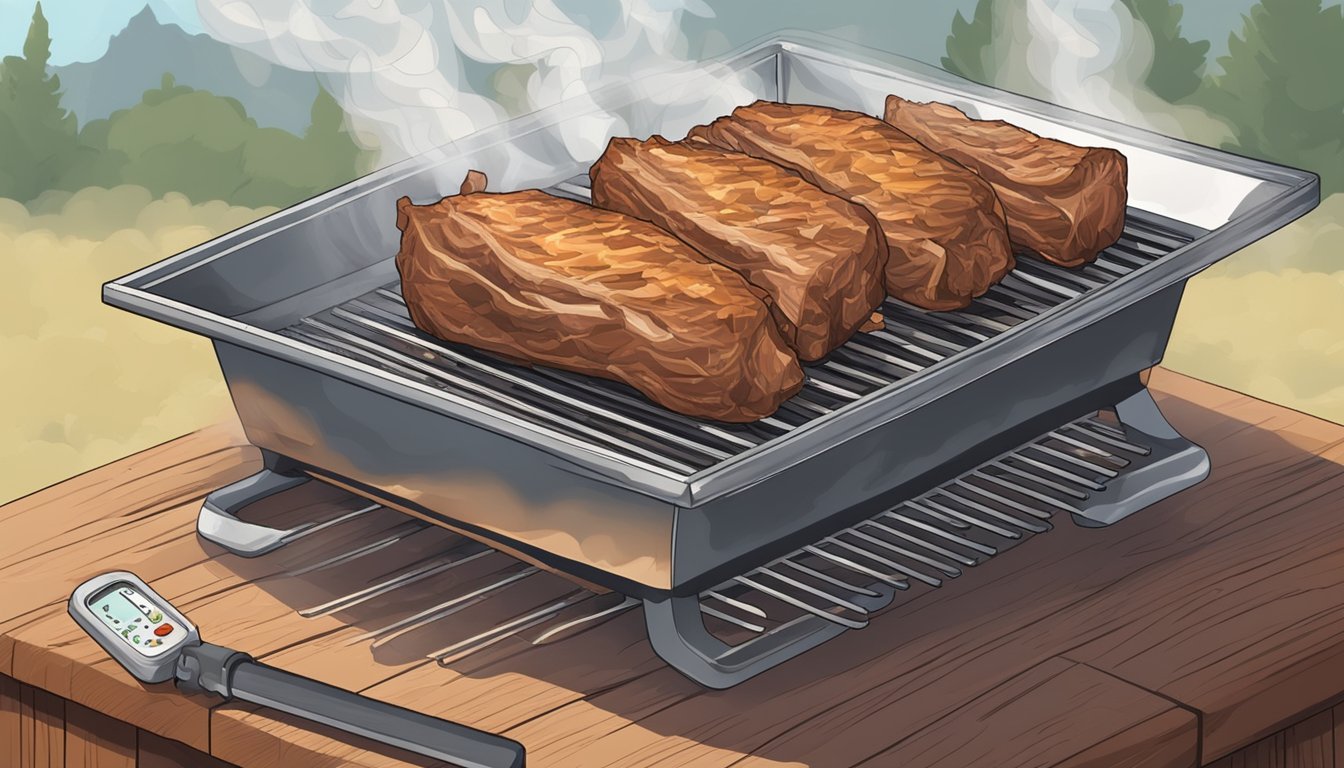Texas Crutch Technique
Mastering the Art of Tender BBQ Meat
The Texas Crutch is a barbecuing technique favored by pitmasters and hobbyists alike for its effectiveness in tackling a common smoking challenge known as "the stall." This period of halted internal temperature increase in meats like pork shoulders, pork butts, and beef briskets (What wine goes well with beef brisket?) can be a test of patience. It occurs when meat hits a temperature range often between 150°F and 170°F, where surface evaporation cools the meat as quickly as it gains heat, causing a plateau in the cooking process. By wrapping the meat in foil or pink butcher paper, the Texas Crutch creates an environment that retains moisture, reduces surface evaporation, and allows the meat to continue rising in temperature.
Wrapping meat implements the crutch method, trapping steam and increasing the internal temperature to break through the stall without excessively drying out the meat. The choice of wrapping—whether it's traditional aluminum foil or the increasingly popular food-grade butcher paper—affects the outcome. Foil creates a tighter seal, trapping more steam and potentially speeding up cooking time by 30-60 minutes, while butcher paper is breathable, allowing some smoke flavor to penetrate and maintain a firmer bark. The method involves adding a liquid like apple juice or apple cider vinegar (how long does apple cider vinegar last?)before sealing to boost moisture levels and infuse flavor.
Besides overcoming the stall, the method facilitates the breaking down of tough connective tissues within the meat, resulting in a more tender product. Personal preferences play a critical role in deciding when to employ the Texas Crutch, frequently depending on the desired texture of the meat’s surface, from moist and tender to a crunchy bark. Whether one chooses to wrap their meat at the start to save time or after it has absorbed ample hardwood smoke for a pronounced smoke flavor, the Texas Crutch remains one of the most popular methods to achieve consistently mouth-watering barbecue (What wine goes well with barbecue?) results.
Understanding the Texas Crutch
The Texas Crutch is a widely adopted method by pitmasters to maintain moisture in meat during the smoking process and to traverse the notorious stall period. It plays a crucial role in ensuring the final product is both tender and delicious.
Definition and Purpose
The Texas Crutch refers to the practice of wrapping a piece of meat, such as beef brisket, pork shoulder, or ribs, in aluminum foil or butcher paper during the cooking process. The primary purpose of this technique is to:
Elevate the internal temperature of the meat by reducing surface evaporation.
Accelerate the cooking time, often saving 30-60 minutes.
Keep the meat moist by trapping moisture, which helps in breaking down connective tissues.
Common additions inside the wrap include liquids like apple juice or apple cider vinegar, as well as other seasonings to boost flavor. A tight seal is essential to ensure the meat benefits fully from the crutching method, allowing for a controlled cooking environment.
Origin and Popularity
The Texas Crutch is believed to have originated in Texas, though its exact origins are not well-documented. It became popular as competitive barbecue pitmasters sought ways to improve both texture and taste while also reducing cook time. Its popularity is due to its effectiveness in cooking large cuts of meat that benefit from long smoking periods at low heat, such as brisket and pork butt.
Pitmasters favoring a firm bark may use a double layer of Reynolds Wrap or food grade butcher paper to prevent over-softening of the crust. Different meats and personal preference play roles in how and when to apply the Texas Crutch, but it remains one of the popular methods to achieve a tender texture without drying out the meat during extended smoking.
Preparing Meat for the Texas Crutch
Proper preparation is key for achieving desired textures and flavors when using the Texas Crutch method. This entails selecting a suitable cut of meat and preparing it with the right trimming and seasoning before it is wrapped.
Choosing the Right Meat
Select cuts of meat that have plenty of connective tissues, such as pork butt, pork shoulder, or beef brisket. These tough, larger cuts benefit from the low-and-slow cooking process that the Texas Crutch provides, as it helps to render the connective tissues and keep the meat moist. The goal is to have a piece of meat that not only withstands the extended cooking time but also comes out tender.
Trimming and Seasoning
Trimming:
Beef Brisket: Trim the fat cap down to about 1/4 inch to ensure even cooking and flavor absorption. Remove any loose meat or excess fat.
Pork Butt: Remove excess fat and silver skin to allow the seasoning to penetrate the meat.
Cold meat: It's easier to trim when the meat is cold since it is firmer.
Seasoning:
Create a rub using a mixture of kosher salt, (how long does kosher salt last?) black pepper, and additional spices according to personal preferences.
Coat the meat evenly with the rub. Some cooks opt for a binding agent like mustard before applying the rub.
Allow the seasoned meat to sit for 30-60 minutes at a minimum, which helps the flavors to penetrate and creates a surface that will develop into a firm bark when smoked.
Remember, the Texas Crutch method involves wrapping the meat in a tight seal of aluminum foil or pink butcher paper once it reaches an internal temperature typically around 150-170°F, after a period of being exposed to indirect heat and hardwood smoke. This will trap in moisture, accelerate the cooking time, and help push through the stall when the meat temperature plateaus.
If you can’t find these ingredients in your local markets, you can order kosher salt, black pepper, and mustard online!
Executing the Texas Crutch Technique
The Texas Crutch is a method used to overcome the plateau in cooking temperature known as "the stall," by wrapping meat to retain moisture and accelerate cooking time. It's essential for ensuring tenderness and preserving juiciness in the meat.
Wrapping Materials
Materials Needed:
Pink Butcher Paper: A breathable option that allows some of the smoke to continue flavoring the meat while also trapping moisture.
Heavy-Duty Aluminum Foil: Creates a tighter seal than butcher paper, effectively trapping all the moisture and heat, but might soften the bark more.
Wrapping Process
Prepare the Wrap:
Lay out a large piece of butcher paper or aluminum foil on a flat surface.
For additional flavor, some pitmasters sprinkle it with spices or drizzle it with liquids like apple juice or apple cider vinegar.
Wrap the Meat:
Place the meat—whether it's pork butt, brisket, or ribs—on the wrap.
Fold the paper or foil over the meat, creating a tight seal. Ensure the ends are folded in to prevent juices from leaking.
Return to Heat:
Place the wrapped meat back on the smoker or grill over indirect heat.
Re-insert a thermometer probe to monitor internal temperature if desired.
Cooking Times and Temperature
Cook Time: Check the meat after 30-60 minutes to adjust based on personal preferences for tenderness and texture.
Internal Temperature: The meat should be smoked until it reaches an internal temperature suited for the type of meat:
Pork shoulder and pork butt: 195°F-205°F for optimal tenderness.
Beef brisket: 200°F-205°F, ensuring connective tissues have broken down sufficiently.
Note: The exact time to crutch depends on factors such as the cut of meat, size, and specific stall time.
Factors Affecting the Stall
When smoking meats, such as beef brisket or pork shoulder, the internal temperature can plateau during a phase known as "the stall." This phenomenon is influenced by meat physics and environmental elements, both of which are critical for pitmasters to understand in order to manage the cooking process effectively.
Meat Physics
Internal Moisture Evaporation: A key factor in the stall is evaporative cooling, where the meat’s internal temperature levels off as moisture on its surface evaporates, cooling it. Particularly in cuts with significant connective tissues like beef brisket or pork butt, this can occur as the meat temperature rises, causing these tissues to render and release water. The released liquids, often called a "meat sweat," then evaporate and cause the meat's temperature rise to stall.
Surface Evaporation and Connective Tissues: The amount and consistency of connective tissue can affect how much moisture is available for evaporation. As the meat heats, connective tissues break down and become gelatinous, which also affects the evaporation rate and thus the duration of the stall. For instance, thicker cuts like pork shoulder may experience a longer stall due to more extensive connective tissues.
Environmental Influences
Heat Source and Ambient Temperature: The heat from a smoker or grill provides the energy necessary for cooking, but fluctuations in heat levels can lengthen or shorten the stall. For example, if the external temperature is colder or windy, the meat might stall for a longer period due to increased evaporative cooling.
Humidity and Smoke: Higher humidity inside the cooking chamber can cause the stall to last longer due to reduced evaporation rates. Smoke, while adding flavor, can also indirectly contribute to the stall by impacting surface moisture.
Indirect heat methods can help control the cooking environment, minimizing dramatic temperature changes that might otherwise prolong the stall. Understanding these factors can guide a pitmaster to manage the smoking process, potentially wrapping the meat to conserve moisture and maintain a consistent cooking time.
Benefits and Drawbacks of the Texas Crutch
Employing the Texas Crutch method in smoking meats such as pork shoulder or beef brisket can influence both the texture and flavor of the final product. This technique involves tightly wrapping the meat in aluminum foil, sometimes with liquids and seasonings, during a specific stage of the smoking process to alter the cooking environment.
Pros of the Technique
Meat Moistness & Tenderness: Wrapping meat such as beef brisket or pork butt in foil during the cooking process helps to retain moisture. The trapped steam from the liquids, which may include apple juice or apple cider vinegar, softens the connective tissues faster, rendering the meat more tender.
Effective Time Management: Foil-wrapping meat can reduce cooking times by as much as a few hours, as the enclosure provides additional heat and prevents surface evaporation, countering the barbecue stall — a period where internal meat temperatures plateau due to evaporative cooling.
Consistency in Results: Depending on personal preferences, some pitmasters find that the Texas Crutch gives them more control over the meat temperature and consistency, especially for large gatherings or competitions where serving juicy and tender meat on time is paramount.
Flavor Enhancement: For those looking to impart additional flavor, the foil pouch can be an excellent vehicle for introducing elements like brown sugar, fruit juices, or sauces, making the meat not just moist but also more flavorful.
Cons of the Technique
Bark Development: The lack of direct exposure to the hardwood smoke can result in a less crispy bark. Pitmasters who prize a crunchy bark might find the texture after crutching too soft or even mushy, as the moisture inhibits the formation of a firm outer crust.
Trade-off Between Time and Texture: While the crutch method can shorten the cook time by 30-60 minutes or more, this can sometimes translate to a sacrifice in texture. Traditionalists argue that patience — allowing meat to roast unencumbered for plenty of time — yields a superior smoke flavor and bark.
Precision Required: Achieving a tight seal with the foil is crucial; a loose wrap may lead to steam escaping, defeating the purpose of the technique. In contrast, double layering with foil or using a food grade butcher paper, as is the practice at places like Franklin Barbecue, can offer a balance between retaining moisture and still allowing for a firmer bark.
Material Considerations: Pitmasters need to consider the type of wrap used—while aluminum foil is a common choice, some opt for pink butcher paper as a more breathable alternative. This choice can influence both the rate of evaporative cooling and moisture level in the meat.
Using the Texas Crutch is a calculated decision that depends on the kind of results a cook wishes to achieve, balancing the benefits of a moist and tender piece of meat against the potential compromises in texture and smoke flavor.
Enhancing Flavor and Texture
Using the Texas Crutch method, cooks can enhance the flavor and texture of meats like pork shoulders and beef briskets. By wrapping the meat in foil or butcher paper, they can effectively manage internal temperature, retain moisture, and develop a desirable bark on the meat's surface.
Alternative Liquids
When meats are wrapped during the crutch, introducing alternative liquids can add complexity to the flavor profile. For instance, applying apple juice, beer, or wine before sealing enhances the meat's juiciness and infuses subtle fruit or malt notes. A spritz or mop of these liquids on the meat before wrapping also aids in forming a rich, caramelized bark during the initial smoking.
Resting and Serving
Post-crutch, allowing the meat to rest for 30-60 minutes in the wrap ensures that juices redistribute and connective tissues relax, ultimately yielding tender and flavorful cuts. The resting should occur off the heat source, on a cutting board or in a faux cambro, with the thermometer probe still inserted to monitor the meat's temperature. This step is essential for achieving optimal texture and ensuring the meat remains moist and juicy for serving.
Advanced Techniques and Tips
When employing the Texas Crutch method, mastering certain advanced techniques and tips can refine the cooking process and lead to a more consistently desirable outcome, especially in terms of meat's internal temperature, tenderness, and flavor.
Pitmaster Insights
Successful use of the Texas Crutch hinges on closely monitoring internal temperature and understanding the nuances of the cooking process. Experts advise inserting a thermometer probe into the thickest part of the meat, targeting an internal temperature prior to crutching between 150°F and 170°F, where most meat stalls occur due to surface evaporation. To maintain the meat moist while developing a firm bark, timing is key. For example, pork shoulders or briskets should generally be crutched after they've developed a rich color and hit the stall, typically 3-4 hours into the smoking process.
Additionally, understanding the composition of different cuts of meat allows pitmasters to adjust their method. Fattier cuts like pork butt may require less added moisture than leaner cuts due to their inherent fat content. A tight seal with foil or butcher paper is critical to prevent steam from escaping, which helps to break down connective tissues faster, shortening the cooking time by 30-60 minutes or more, depending on the size of the cut.
Alternative Wrapping Strategies
When discussing wrapping materials, two popular methods dominate: aluminum foil and pink butcher paper.
Aluminum Foil: Creates a tight seal that traps moisture, essentially steaming the meat, which greatly accelerates the cooking process and helps to keep the meat tender. However, this can also lead to a mushy bark if not managed correctly.
Pink Butcher Paper: This porous wrapping material allows for better smoke penetration and aids in preserving the crunchy bark. It absorbs some of the moisture, mitigating the risk of a steamed texture, and is preferred for those wanting to enhance the smoke flavor.
For additional flavor, some pitmasters sprinkle brown sugar or spritz with apple juice or apple cider vinegar before wrapping to add a subtle sweetness and help with caramelization. To wrap, place the piece of meat on a double layer of your chosen material, bring the edges together, and crimp to create a tight seal. Return the wrapped meat to the smoker or grill and continue cooking until the desired internal temperature is reached, often around 195°F to 205°F for brisket and pork shoulders. It is crucial to rest the crutched meat on a cutting board for at least an hour before serving to allow the juices to redistribute.
Beyond Brisket: Texas Crutch Variations
While the Texas Crutch is commonly associated with achieving tender brisket, this method extends its benefits to other meats and even vegetables. Exploring these variations allows for moisture retention and reduced cooking times, expanding the culinary potential of this technique.
Ribs and Pork Shoulder
The Texas Crutch is highly effective for pork ribs (What wine goes well with pork ribs?) and pork shoulder (also known as pork butt), especially when aiming for fall-off-the-bone tenderness. Slow cooking these cuts can often lead to meat stalls, where internal temperatures plateau. Wrapping ribs or pork shoulder in foil or pink butcher paper can overcome this by creating an environment that limits surface evaporation, thus speeding up the cooking process.
Internal Temperature: For pork ribs and shoulders, aim for an internal temperature of 195-205°F (90-96°C), using a thermometer probe to check.
Crutch Time: Implement the crutch when the meat reaches around 150-160°F (65-71°C) and cook until the desired temperature.
Using liquids like apple juice or a mix of apple cider vinegar and water can be brushed onto the meat before sealing in foil, adding moisture and enhancing flavor.
Other Meats and Vegetables
The Texas Crutch isn't limited to traditional barbecue meats. Various cuts of meat such as lamb shoulder, goat, or even large roasts can benefit from this method. In these cases, the goal is to tenderize connective tissues without drying out the meat. Vegetables, particularly those that take longer to cook like potatoes or whole pumpkins, can also be wrapped to retain moisture and cook more evenly.
Non-Meat Uses: Wrapping corn in foil with butter or coating tougher vegetables in oil can lock in flavors and steam them effectively.
Experimenting with Flavors: Incorporating fruit juices, spices, or barbecue sauce in the wrap can infuse the items with extra flavor.
Whether wrapping ribs in a double layer of foil or using food grade butcher paper for a whole packer brisket, ensuring a tight seal is crucial to prevent steam from escaping and to keep the contents moist. Adjustments in timing and temperature may be based on personal preferences for the end result, such as a crunchy bark on meats or firm bark on vegetables.
Conclusion
The Texas Crutch is a method employed by pitmasters to maintain moisture in the meat during long smoking sessions and to overcome the notorious barbecue stall. Wrapping meat in aluminum foil or pink butcher paper—the two primary materials for this technique—helps retain moisture and increase internal temperature. This can result in a faster cooking time, often reducing cook time by 30-60 minutes.
When using the Texas Crutch, certain considerations should be kept in mind. While the technique helps in maintaining meat moist and tender by reducing surface evaporation, it may also soften the bark, which is the coveted crunchy exterior of the smoked meat. Pitmasters often add liquids like apple juice, apple cider vinegar, or sauce inside the wrap to enhance flavor and tenderness.
The type of meat being cooked typically dictates the timing of the crutch. Tougher cuts with more connective tissues, like a pork shoulder or beef brisket, benefit most from this method. Meat should be crutched after it has absorbed enough hardwood smoke flavor and has reached a plateau in temperature, known as the stall, usually around 150°F to 170°F.
Each pitmaster approaches the Texas Crutch with personal preferences, deciding when to apply it based on observations like the firmness of the bark or the specific texture desired. After wrapping, it's crucial to ensure a tight seal. Upon finishing the cook, one should also allow the meat to rest before serving, allowing it to reabsorb juices and ensuring the fibers relax for optimal tenderness.
Ultimately, whether to use the Texas Crutch is a subjective choice that depends on individual goals for texture, moisture, and flavor, as well as the specific demands of the meat and the smoking environment. It stands as one of the most popular methods among competitive barbecue teams and backyard enthusiasts alike, as it strikes a balance between succulent flavor and efficient cooking.

